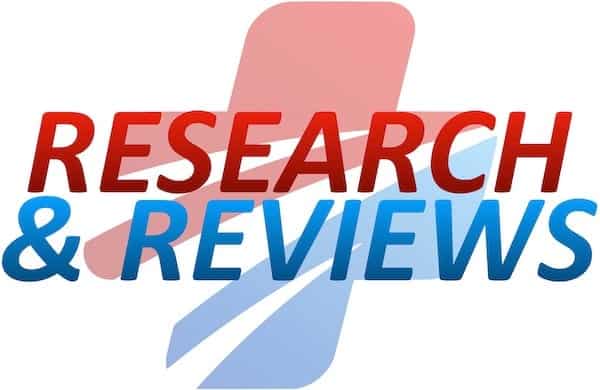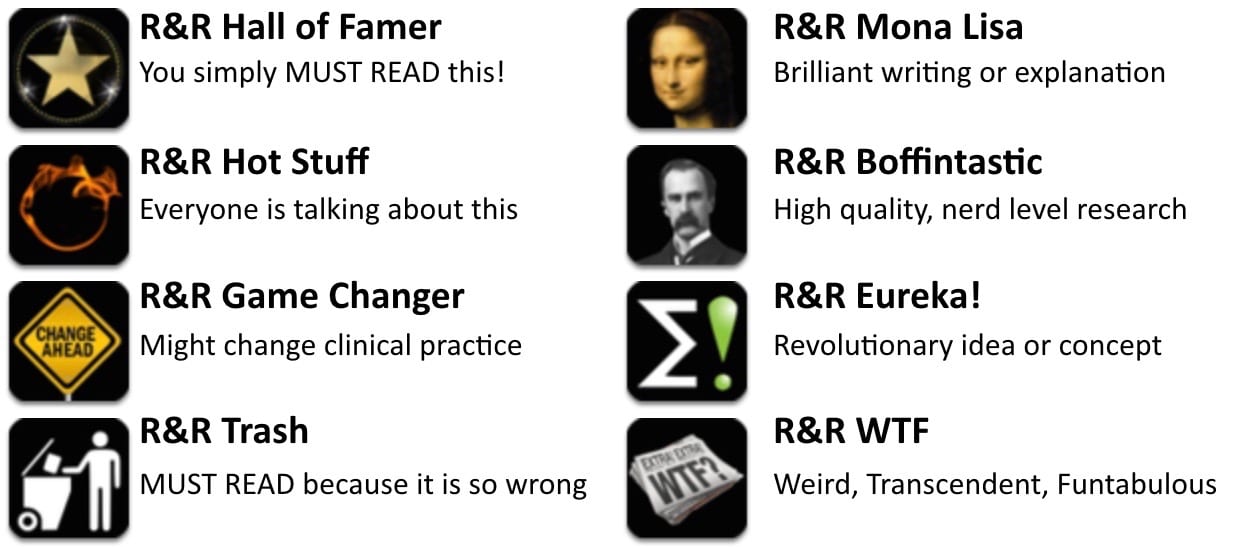R&R In The FASTLANE 008
Welcome to the 8th edition of Research and Reviews in the Fastlane. R&R in the Fastlane is a free resource that harnesses the power of social media to allow some of the best and brightest emergency medicine and critical care clinicians from all over the world tell us what they think is worth reading from the published literature.
This edition contains 10 recommended reads. The R&R Editorial Team includes Jeremy Fried, Nudrat Rashid, Soren Rudolph, Anand Swaminathan and, of course, Chris Nickson. Find more R&R in the Fastlane reviews in the : Overview; Archives and Contributors
This Edition’s R&R Hall of Famer
Abd-el-Maeboud KH, el-Naggar T, el-Hawi EM, Mahmoud SA, Abd-el-Hay S. Rectal suppository: commonsense and mode of insertion. Lancet. 1991 Sep 28;338(8770):798-800. PMID: 1681170
- This little known classic has never been repeated, but it has sparked a debate that continues to this day: What is the best direction to place a suppository – pointy or blunt end first? The authors challenged conventional wisdom as well as manufacturer instructions and tested their theory – that blunt end was best – on 100 unwitting patients. The rate of needing to insert a digit in the anal canal to push the suppository further in was 1% in the blunt end group versus 83% for pointy end first. Unwanted suppository expulsion rate was also lower in the blunt end group.
- Since this is the only study of its kind, questions have been raised as to whether it should be practice changing.
- It is for me. That’s all I can say.
- Recommended by: Rob Orman
Kumar RD, Hirsch NP. Clinical evaluation of stethoscope-guided inflation of tracheal tube cuffs. Anaesthesia. 2011 Nov;66(11):1012-6. doi: 10.1111/j.1365-2044.2011.06853.x. Epub 2011 Aug 18. PMID: 21851343.
- A cool, practical study although patient numbers are small.
- Recommended by: Sa’ad Lahri
Bershad EM, Suarez JI. Prothrombin complex concentrates for oral anticoagulant therapy-related intracranial hemorrhage: a review of the literature. Neurocrit Care. 2010 Jun;12(3):403-13. Review. PMID: 19967567.
- PCC Review: PCCs ARE AVAILABLE IN THE US!!! PRofilNine SD is roughly equivalent to Octaplex!
- Recommended by: Mike Jasumback
Latronico N, Bolton CF. Critical illness polyneuropathy and myopathy: a major cause of muscle weakness and paralysis. Lancet Neurol. 2011 Oct;10(10):931-41. Review. PMID: 21939902.
- Go the early rehab. A good review of a classic topic.
- Recommended by: Oliver Flower
Armfield DR, Kim DH, Towers JD, Bradley JP, Robertson DD. Sports-related muscle injury in the lower extremity. Clin Sports Med. 2006 Oct;25(4):803-42. PMID: 16962427
- We see lots of muscle strains and soft tissue injuries. This is a good review of what specific anatomic injuries are occurring.
- Recommended by: Andy Neill
Hudson ML, Moore GP. Defences to Malpractice: What Every Emergency Physician Should Know. J Emerg Med 2011;41:598-606. PMID: 21094012
- A medical malpractice suit must contain four elements: duty; breach of standard of care (negligence); injury; and proximate cause. However, even if all these factors exists, there are additional specific defences that physician can claim: including contributory negligence, comparative fault, respectable minority, clinical innovation, and Good Samaritan exclusion.
- Although most of these specific defences seem to me included in the original 4 elements, the authors give a good summary of this topic.
- Recommended by: Leon Gussow
Nguyen-Khac E, Thevenot T, Piquet MA, Benferhat S, Goria O, Chatelain D, Tramier B, Dewaele F, Ghrib S, Rudler M, Carbonell N, Tossou H, Bental A, Bernard-Chabert B, Dupas JL; AAH-NAC Study Group. Glucocorticoids plus N-acetylcysteine in severe alcoholic hepatitis. N Engl J Med. 2011 Nov 10;365(19):1781-9. PMID: 22070475.
- NAC – is there anything we can’t try it for. Negative trial statistically but results all leaning toward benefit. 8% v 24% mortality at 1 month vs placebo
- Recommended by: Andy Neill
- Learn more: Emergency Medicine Ireland – NAC for alcoholic hepatitis
Mellick LB. Torsion of the Testicle: It Is Time to Stop Tossing the Dice. Pediatr Emer Care 2012;28:80-86. PMID: 22217895
- Great in-depth discussion of the myths and misconceptions related to the presentation and diagnosis of testicular torsion. Bottom line recommendation: image every patient with scrotal or testicular pain whose history and physical is not consistent with torsion. Clinically obvious torsion should go directly to urology for exploration.
- Recommended by: Leon Gussow
Vazirani J, Knott JC. Mandatory Pain Scoring at Triage Reduces Time to Analgesia. Ann Emerg Med. 2011 Sep 9. PMID: 21908072
- If you want your patients to get analgesia quicker… ask the triage nurse to do analgesia scores. Will it affect the ATS category as well??
- Recommended by: Ioana Vlad
Doyal L. Should the skeleton of “the Irish giant” be buried at sea?. BMJ 2011; 343. PMID: 22187392
- A story from a time when ethics was not a word.
- Recommended by: Ioana Vlad
Chris is an Intensivist and ECMO specialist at The Alfred ICU, where he is Deputy Director (Education). He is a Clinical Adjunct Associate Professor at Monash University, the Lead for the Clinician Educator Incubator programme, and a CICM First Part Examiner.
He is an internationally recognised Clinician Educator with a passion for helping clinicians learn and for improving the clinical performance of individuals and collectives. He was one of the founders of the FOAM movement (Free Open-Access Medical education) has been recognised for his contributions to education with awards from ANZICS, ANZAHPE, and ACEM.
His one great achievement is being the father of three amazing children.
On Bluesky, he is @precordialthump.bsky.social and on the site that Elon has screwed up, he is @precordialthump.
| INTENSIVE | RAGE | Resuscitology | SMACC







